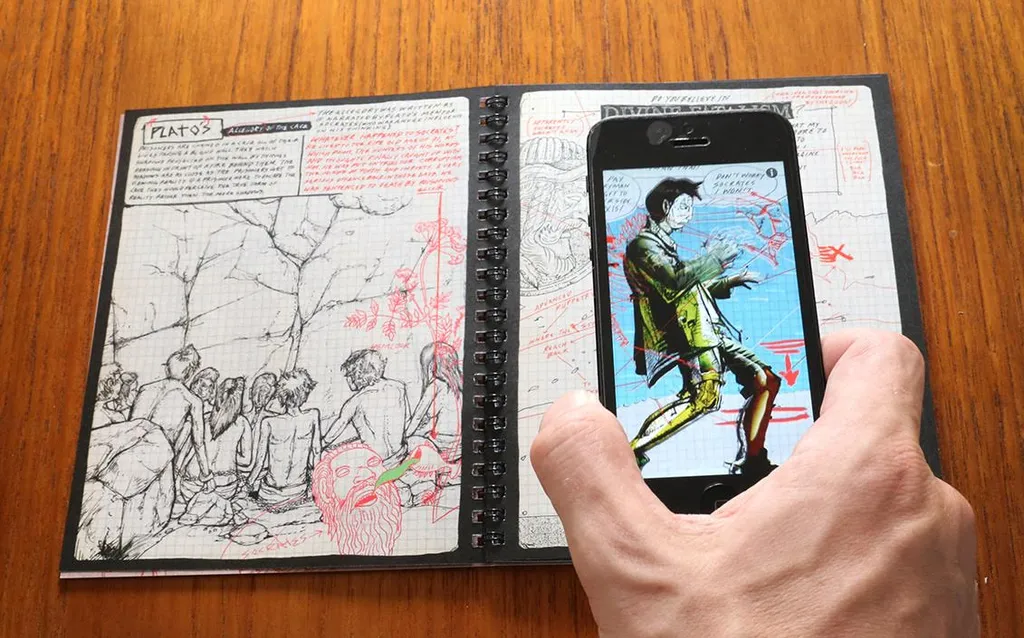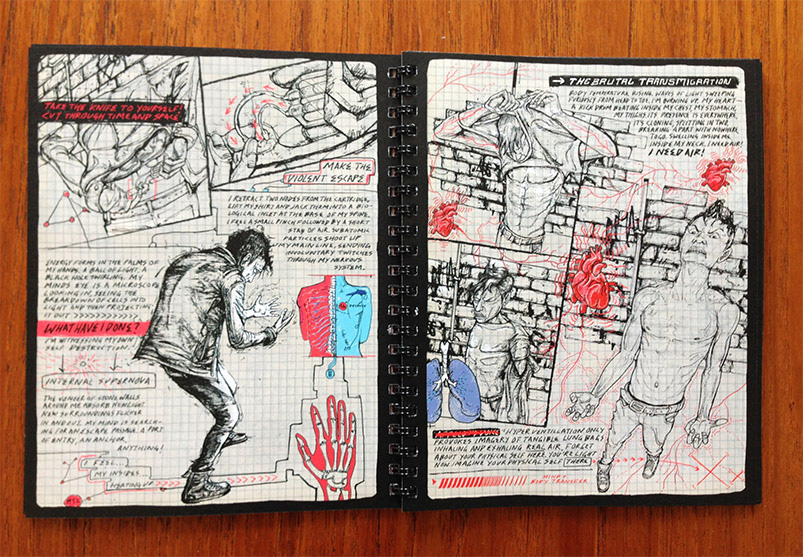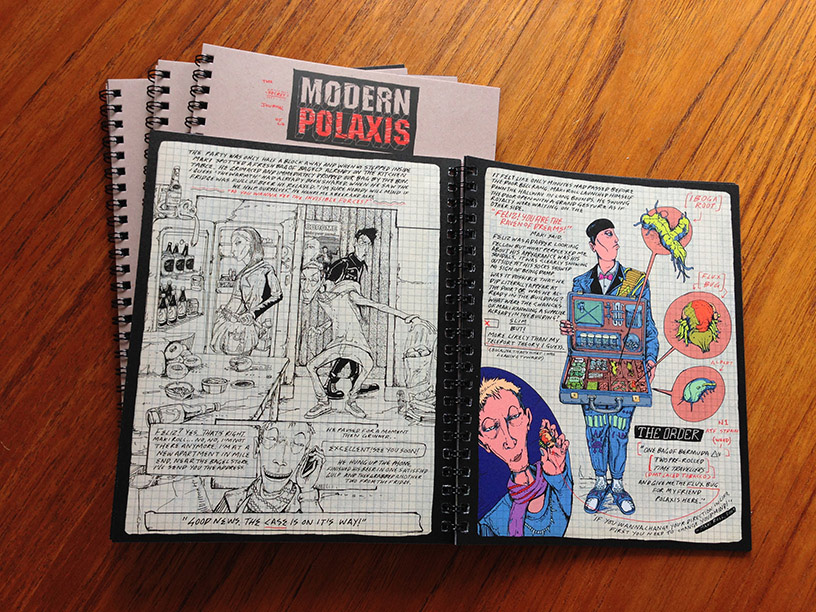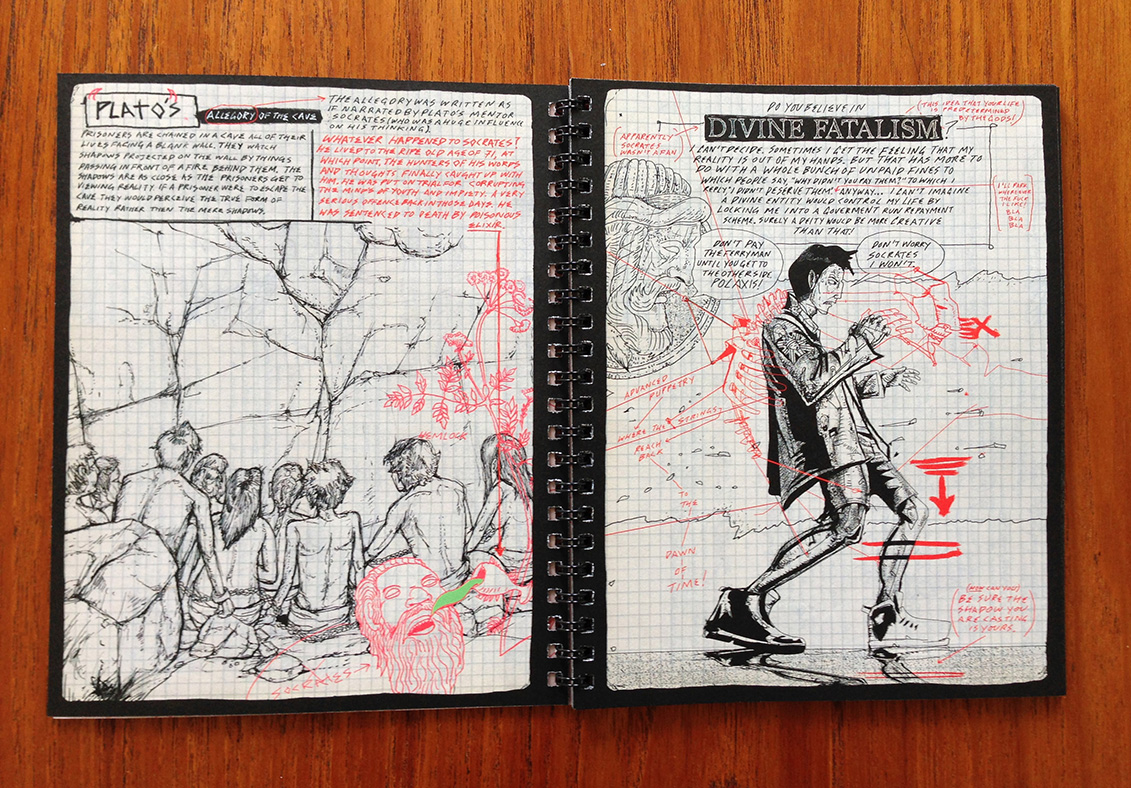Hitting a 20 year high of $870 million in 2014, the comic book business is booming. While highly produced, much viewed television and box office dominating films have increased exposure, a large part of the industry’s staying power is due to the availability of digital print comics through services like Marvel Unlimited and Comixology. More and more people are reading comics on tablet and cell phone screens, but Modern Polaxis is bringing physical print and devices together in a different way.
In the comic Modern Polaxis, the title character is a paranoid time traveler. “He believes our reality is a projection from another plane in the universe and his mission is to find the projectionist,” says Stuart Campbell, also known as Sutu, the book’s creator. “The book is designed to look like his personal notebook and he hides all his secret information in the layer of augmented reality.”
While having your comic book on a digital device is convenient, Sutu is using Modern Polaxis to make print and digital comics a synonymous experience. Readers flips through the pages depicting various scenes and we piece together a moving work mentally with whatever context we draw from each segment.
With AR, those pages come to life, add even more layers to the experience, and remove the limitations of static imagery that even the greatest artists are bound by. On one page, you may see energy pulsating through the lead character’s body or him moving as he struggles with a device and, on another, you’ll have background images simulating movement through the sky.
The comic book and augmented reality also gives the reader multiple perspectives as we witness Polaxis’ mental breakdown and the process as he puts the pieces back together. You can flip through the pages without using AR, but you’d only get half the story. “There is Augmented Reality on every single page and much of it is telling a different story to what is printed on the page,” Sutu explains. There are moments where the augmented reality not only adds more details to what’s written in the book, but also crosses entire segments out and changes what the reader sees.
Often an artist is pushed to action by admiration of previous pioneer’s work. Sutu’s other projects have been inspired by the likes of French painter and cartoonist Moebius, manga artist Katsuhiro Otomo, comic book artist Geof Darrow, and animator Peter Chung. The concept for Modern Polaxis, though, was birthed a different way.
The true inspiration for Modern Polaxis traces back to an AR street project that ended up taking shape as the product we have today. “I pasted two life size Polaxis posters on some walls in Sydney’s back alleys and we made them come to life with an AR projection. We were really happy with the result and decided to create an AR comic book.”
From there, Sutu presented a couple mock pages to an organizer of the Fantoche animation festival in Switzerland and that organizer challenged Sutu to show up at the festival, three months later, with a finished comic book. With the help of fellow digital artist Lukasz Karluk, who hammered out hardcore coding for image recognition and animation mapping, Sutu created the art and animation framework that manages all of the Polaxis content.
The motivation to find hidden details in the comic closely parallels the Pokemon Go experience and actions like these bode well for AR’s future. There are still some barriers to manage on the development side, though. “A big one was memory management,” he explains. “It’s impossible to know which page the reader will turn to first so you need to have all AR animations loaded and ready to go – which means all animations need to be loaded into the device’s memory.”
Managing such a feat is dubious on its surface level, but even more complicated when you consider that memory stores can differ greatly from user to user. So not only must you keep file sizes as small as possible, you must also remain mindful of future updates to the IOS firmware (as of the time of this article, Modern Polaxis is only on IOS).
Pokemon Go has brought augmented reality to the hands of casual users, typically a key in any tech’s growth. While Pokemon Go is still a worldwide phenomenon, AR still has a ways to go before becoming a staple in this digital age. “I think we’re all waiting for some kind of Google Glass kind of tech that can support reasonable graphics,” Sutu says. “At the moment it’s kind of strange to point your phone at a book in order to read it and, for Polaxis, I tried to play with this obstacle by choosing a story that required a bit of work from the reader.”
The additional layers allowed via augmented reality benefit any creative work, but Modern Polaxis and a Sutu’s future project’s subject matter offer rare topics that thrives in a platform where perception of reality is its defining trait. As designers take advantage of this opportunity to tell unique stories like Modern Polaxis, augmented reality will hopefully become commonplace and inspire evolution in the technology so limited graphics becomes a thing of the past.
You can purchase the comic book from the official website here and the iOS app required to view the AR capabilities of the comic can be downloaded for free from the App Store. For more of Sutu’s work, check out these fantastical Tilt Brush creations and this mixed reality camera robot.





























